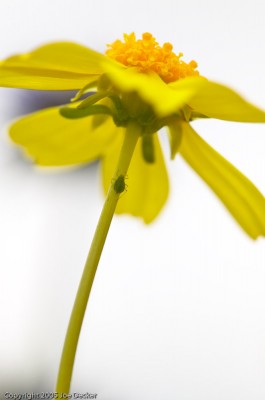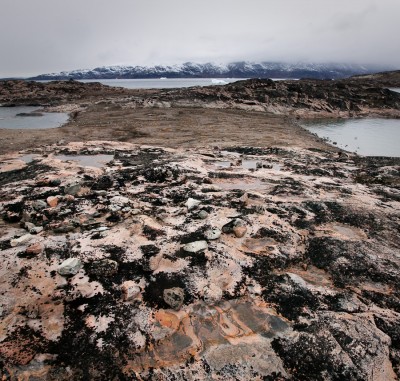
If you like this article, you can now get the book! Joe has expanded the “Tuesday Composition” series into an inspiring new ebook on composition, especially for nature photography. Check it out: The Tuesday Composition.
The week before last we talked about moving: about what a difference moving a foot to the left or right, forward or back can make in a composition. Today we’ll continue along that theme, talking about what a difference moving higher or lower can make.
We often photograph from “eye-level.” It’s a fairly natural tendency, if we make photographs after seeing things that move us, we’ll typically end up finding compositions at eye level. This is a good choice for point of view, photographing from “eye level” often produces images that read very naturally to the viewer.
But “eye level” isn’t always your best choice.
Sometimes shooting from lower perspectives comes naturally. When photographing small desert sunflowers in Joshua Tree National Park a few years back, it never occured to me to photograph from eye level because in many cases the flowers were only a foot or less off the ground. It was and is natural (and effective) to get lower and closer to these flowers.
Aphid and Desert Sunflower, however, took “getting lower” even farther, moving below the level of the flower in order to place it against an overcast sky. Not only does this make for a nice 70s color scheme, but perhaps more importantly, it helps us see from something closer to the aphid’s point of view, connect with the high aspirations that it’s easy to anthropormorphically project onto it.
Low points of view are often useful in creating dramatic near-far compositions-when we really want to emphasize the foreground in a wide-angle composition we’ll need to be close to that foreground, and often eye level is just too far away.
Higher perspectives are a different matter entirely. Sometimes they’ll come naturally, as we look down on a landscape from the top of a mountain or cliff. These very high perspectives can be quite interesting, and sometimes help convey a sense of vastness, as in MacDonald Valley and the Livingstone Range. Often these images end up being peaceful and perhaps a little bit detached, more like we’re flying over the landscape rather than immersing ourselves in it.
But there are other situations in which it is less natural to consider a higher perspective, and yet quite useful. Many photojournalists understand this from experience, if you have a big crowd of people it’s going to be difficult to make a photograph that communicates that from eye level. Instead, if you reach up with your camera and shoot with a wide angle from overhead, you’re more likely to be able to capture both some of the scale of the crowd but also still grab some action from the people surrounding you, this is a classic “show the crowd” shot.

Moving your camera up isn’t always so obvious, or, for that matter, easy. I received an excellent lesson on this point some years back when I had the opportunity to visit East Greenland, a trip that was in part a workshop with National Geographic legend Frans Lanting. We came across some ancient Thule rock circles a few miles inland in within Scoresby Sund, and Lanting poised the question to me of how to bring out the sense that the rocks were in a large circle, most eye-level perspectives reduced the circle to a narrow line.
He pointed out that the circle would be a lot clearer from, say, ten feet above the ground, which left me thinking (and I was a bit slow here), how am I going to get my tripod that high? His answer was simple yet, at the time, completely unexpected. He demonstrated holding his tripod (camera well attached) way over his head, triggering the shutter through use of a 2-second timer), and achieving the right composition with a combination of repititive trial and error, and a little bit of horizon levelling and cropping in post.
Don’t let yourself be limited by the convienence of eye-level, when photographing, keep an eye on the ways in which raising or lowering your camera can bring new perspective and interest to your compositions.
www.photocrati.com
4 Jun 2011The tuesday composition new perspectives.. Ho-o-o-o-t 🙂